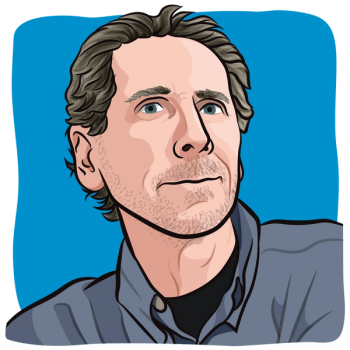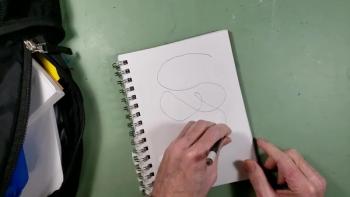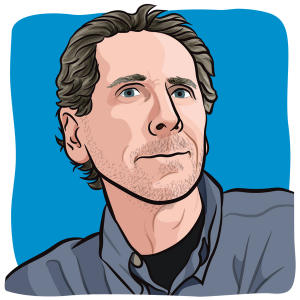
Good news in the cancer space is great, but we need to share more cancer stories about the good, bad and the ugly

Mark is a retired freelance artist and illustrator who has created hundreds of works of art for books, magazines, greeting cards, websites and countless other publications over a long career. After retiring, he hoped to just live a simple life, maybe do volunteer work with his wife at some National Parks and continue to paint, sculpt, and do other creative works – but this time just for art’s sake. However, his wife received a BRCA2-associated cancer diagnosis that shattered that dream. Mark became his late wife’s caregiver as she struggled with metastatic triple-negative breast cancer and all the horrible side effects that come with treatment. In turn, he became a hereditary cancer awareness and prevention advocate. And since his daughter also carries the same germline BRCA2 mutation, he said that his advocacy means even more.

Good news in the cancer space is great, but we need to share more cancer stories about the good, bad and the ugly

It is happening again.

With National Hereditary Cancer Week and National Previvor Day coming up at the end of the month, I sat down to write something about cancer advocacy and being the parent of a previvor.

Cancer is truly @#%^%# %#*$!, so go ahead and let the anger out!

The importance of cascade genetic testing has led me to advocate through my artwork.

It’s strange how an event can unfold on the national stage, and it validates something that you have been pointing out for years.

In my wife’s family, the same pathogenic BRCA2 mutation is shared among 1st, 2nd, 3rd, 4th, 5th and possibly 6th degree (too young to test) blood relatives.

I recently underwent genetic testing to see if I had any mutations that could be associated with an increased cancer risk.

I don't remember the first time I heard the word "germline," but I do remember when it became a major part of my life.

I use the word "previvor" a lot, so I wanted to take a minute to reflect on what that means.

While waiting for my daughter to get a prophylactic cancer surgery, I sketched a cartoon that I hope will get people talking about hereditary cancer risks.

A common — but toxic — flower is being used to treat cancer.

On Feb. 6, HB 2783 was introduced into the Arizona House. Hopefully this bill will help address some of the issues surrounding genetic testing, genetic counseling, and insurance coverage for those who might be at risk for hereditary cancer. My wife died of a cancer that was totally preventable. Nobody should die of a preventable cancer.

When my wife was going through breast cancer treatment, I started drawing with my non-dominant hand as a means of distraction and self-care.

Reflecting on World Cancer Day got me thinking about butterflies, a symbol of hope, but, according to the “Butterfly Effect” theory, a small flap of their wings could have major impacts on the world, which is not very different from cancer.

When my wife was going through cancer treatments, she sometimes would color my artwork as a distraction. Here’s an activity I made for other survivors, now that it’s the year of the rabbit.

As I work on a holiday drawing, the coyotes are howling outside, while inside, my cat and I are reminded of my wife who died of breast cancer.

Educating people about cancer can not only be life-saving, but is also a kind thing to do. I was reminded of this by a post from a children’s author who died of cancer.

Being a creative, I learned to solve many of the problems that life threw my way. But being artistically gifted was worthless for dealing with the stark realities of my wife’s cancer.

I know that cancer is not lighthearted but wanted to offer a fun Halloween drawing activity for those affected by the disease.

Truly raising awareness for breast cancer — or any other disease — can’t be done with walks and colorful ribbons, but through seeing the people who are affected by the illness.

A professional illustrator and former cancer caregiver uses a detailed step-by-step approach using simple shapes such as circles and rectangles to demonstrate how others can easily draw a lion.

I'm suggesting a new medical discipline called "previvology" that is dedicated to the detection of genetic mutations and the prevention or early detection of cancers that are associated with them.

As National Previvor Day approaches, I’m getting back on my soapbox to discuss genetic testing and family histories of cancer. After all, these discussions could save lives.

Here's a step-by-step guide on how I drew the superhero that I wish existed to fight my wife's cancer.

Gender be damned, a mother bear’s “fierce compassion” became my default mode as I cared for my ailing adventure partner and soul mate.

Drawing helped me stay grounded while my wife was going through cancer treatment.

As I enter my second year of grief and the shock and fog of the traumatic loss of my wife to cancer has waned a bit, sometimes I see things a little clearer. And one thing I do know, there was something that I did get right.

When participating in FORCE’s Virtual Advocacy Day, it was difficult for me not to go off-script, as anger welled up inside me.

My daughter is a cancer “previvor” because she inherited a cancer gene from her mother, so this Father’s Day, I’m celebrating her, too.

Published: September 12th 2022 | Updated: